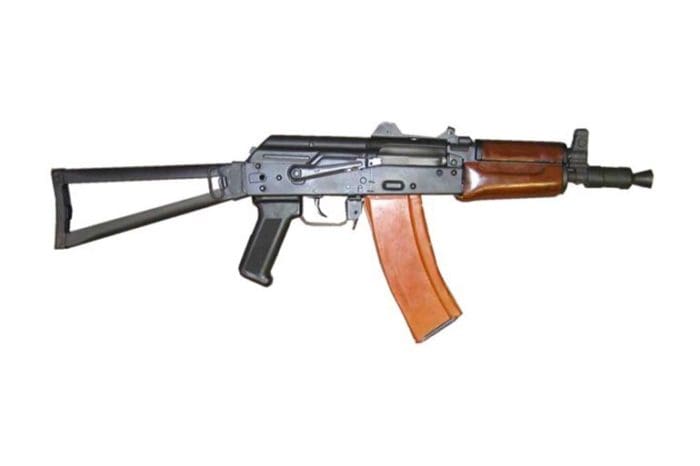Now that the question is answered, we can talk about something else, like how the Raiders are finally going to turn it around this ye…just kidding. We’re going to go over it more, and I’d be shocked if they do better than 8-8.
There’s a practical use for a gun that fits somewhere between a submachine gun (spray and pray up close and personal) and a fully-fledged battle rifle/service rifle/assault rifle/whatever term you feel like using. It’s useful at close quarters but can be used at longer ranges than a submachine gun.
There are versions that our military uses, us civilians can turn to the burgeoning SBR and AR-pistol market, and the Soviets have the Krinkov. However, they don’t call it the “Krinkov;” the gun is properly titled the AKS-74U.
Some details are probably going to be missed for the sake of brevity so feel free to either fill them in (or complain) in the comments.
Military personnel and law enforcement who go in and out of buildings a lot have obvious need for a weapon of that sort and it’s also more practical for certain other personnel that should have a gun but maybe not a full-meal-deal service rifle.
That’s why Colt made the Commando, a short barrel AR for US forces and the Soviets felt like they’d better cook up the same thing after Soviet observers and advisers saw the Commando in action (or observed the after-effects) in the Vietnam war.
A few prototype weapons were developed (such as the AO-46) in the late 1960s but the first official issue SBR/AK pistol didn’t go into production until the mid 1970s. At the time, the Soviet Union was transitioning from the AKM (a revised AK-47 still in 7.62x39mm) to the AK-74.
It had many design elements of the AK/AKM but was revised for the 5.45x39mm cartridge, which was devised to net all the same benefits that the US military found the 5.56mm round had.
In 1973, the Soviets announced a design competition for an SBR variant of the AKS-74, a folding-stock model of the AK-74. The project was called the “Modern.” They wanted it to be ultra-portable, with an overall length of less than 30 inches with the folding stock unfolded, 5 or fewer pounds of overall weight, higher profile sights than the standard model and an effective range out to about 500 meters.
Mikhail Kalashnikov (and others) created versions for consideration (including Yevgney Dragunov, the guy who invented the sniper rifle bearing his name) but ultimately Kalashnikov’s design was selected, entering production as the AKS-74U.
The AKS-74U was noted for handling well in close quarters and having an effective range out to 400 meters, as the shorter barrel robs bullets of velocity. (Longer tube, more spinning, bullet fly faster.)
The Soviet army basically deemed that not to be a big deal and started production at the Tula factory rather than Izhmash, and some production also occurred in Soviet satellite states as well. It has remained in service ever since.
As a result, it was more or less issued to tank, armored vehicle and helicopter crews sort of like the M1 Carbine in the US armed forces during WWII. Paratroopers were issued the standard AKS-74, which had a folding stock but had the standard carbine-length barrel.
The Soviets never called it a “Krinkov.” According to an excellent article at The Firearm Blog, Soviet troops usually referred to it as “Kyushka” (the diminutive of the name Ksenia, like calling a Katherine “Katie” or “Kat”) “Okurok” (cigarette butt) or “Suka.” You can look that last one up.
There are a few competing theories as to where the name came from.
The first theory is that mujahideen in Afghanistan took one from a captured soldier named “Krinkov” or something along those lines. They started calling it that, and when the US government bought a few in Afghanistan for study, the name followed with it.
Another theory has to do with the import market. A certain number of deactivated Krinkov rifles found their way into the United States prior to the Clinton assault weapon ban. One of the popular suppliers was a store called “Krinks” in Naples, Fla. The owner, one Paul Mahoney, bought the deactivated rifles and restored them to working order in semi-auto only, which were called Krink kits.
However, The Firearm Blog also points out what the author believes is the most likely etymology of the word, which I tend to agree with, is that “Krinkof” and “Kalakof” are the colloquial names for “Kalashnikov” rifles, since Russian words don’t transfer well into either dialect of Pashtu since the accents and consonants are very different. (The author asserts Pashtu lacks the letter “v.” Knowing literally nothing about the Pashtu language, I must take his word for it.) Since that’s what they call it and that’s what US advisers heard them call it, the nickname followed with them.
Since the guns were rare (mujahideen had to shoot down a helicopter to get one) acquiring one was a real feat, a status symbol, and many people were willing to pay a lot of money to get one. Osama Bin Laden was known for toting one (though he probably didn’t get his the hard way) which has kept it a status symbol among modern-day mujahideen.
Anyhow, enough Americans in the service heard them referred to as “Krinkovs” or “Krinkofs” that the name stuck. It’s fallen out of use to a degree, as most of us kids these days call it an “AK Pistol” rather than a Krinkov.
Since we covered a lot of territory here, any errors or omissions were made for the sake of brevity. Feel free to expand in comments. But with that said, that’s what a Krinkov is.
